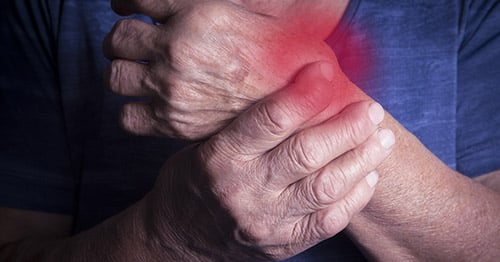Lupus and Joint Involvement – Top 10 Series

- What is systemic lupus erythematosus (SLE or “lupus”)?
- What are the general medical terms used to describe joint involvement in lupus?
- How common is joint involvement in lupus?
- What are the possible causes of joint involvement in lupus?
- What are the symptoms of joint involvement in lupus?
- What tools are used to assess the severity of joint involvement in lupus?
- Should I be worried about long-term joint damage (deformities)?
- What are the diagnostic steps to take in patients with joint involvement and suspected lupus?
- How is joint pain or swelling treated in lupus patients?
- What are the non-pharmacological strategies for joint involvement in lupus?
1. What is systemic lupus erythematosus (SLE or “lupus”)?
Systemic lupus erythematosus (SLE), often referred to as simply “lupus”, is a chronic, systemic autoimmune disease that affects many organ systems – most commonly the skin, joints, and kidneys. Due to persistent, lupus-specific autoantibodies (antibodies that attack your body’s own, healthy self-produced proteins) in the blood that cause tissue damage, the clinical manifestations of lupus are diverse. Common symptoms include fatigue, joint pain and swelling, skin rash (especially “butterfly rash” on the face), and sensitivity to light.1
2. What are the general medical terms used to describe joint involvement in lupus?
Arthralgia and arthritis are the two main terms used to describe joint involvement in lupus patients.
- Arthralgia means pain in a joint.
- Arthritis means swelling and tenderness in a joint due to inflammation (redness and warmth can also develop around the joint).
Additional terms to describe joint involvement include the following:
- Synovitis means inflammation in synovium (connective tissue that lines the joint capsule) of the joint.
- Avascular necrosis or osteonecrosis means cell death of bones because of decreased blood flow.
- Jaccoud’s arthropathy means a deforming arthritis that can be seen in lupus patients, because their joint capsules become looser.
- Tenosynovitis means inflammation in the sheath surrounding a tendon.
3. How common is joint involvement in lupus?
Joints are the most commonly involved parts of the body in people who have lupus. In addition, they are also usually one of the first parts of the body to be affected by the disease. These statistics may help you understand better the frequency of lupus-related joint problems: 2,3,4
- 95% of lupus patients have joint problems.
- 50% of lupus patients may have joint problems as the first sign of their disease.
- 10% of lupus patients develop deforming arthritis (Jaccoud’s arthropathy).
- 5% of lupus patients develop avascular necrosis.
4. What are the possible causes of joint involvement in lupus?
Both arthralgia and arthritis may develop due to different underlying problems, including autoimmune disease (for instance, SLE) or mechanical reasons (for instance, osteoarthritis). Inflammation of the joint capsule lining (synovitis) causes the arthritis in lupus patients, however SLE may not be the only reason of all the joint problems that patients experience.
Other possible causes include (but not limited to):
- osteoarthritis
- avascular necrosis
- osteoporotic bone fracture (broken bone resulting from osteoporosis)
- infectious arthritis
- crystal-induced diseases, such as gout
- fibromyalgia
- vitamin D deficiency
- thyroid gland disorders
Patients should always talk to their doctors to find out if their joint involvement can be related to problems other than lupus, keeping in mind that sometimes multiple underlying problems occur together.
5. What are the symptoms of joint involvement in lupus?
Symptoms can range from arthralgia (pain only) to arthritis with stiffness, tenderness, swelling, and redness. Any joint can be affected, but the most commonly affected joints in lupus are those in the hands, wrists, and knees. Usually the joint involvement is symmetric (meaning, if your left knee is affected, so is your right), however, both arthritis and arthralgia can be “migratory,” which means that the symptoms may affect different joints at different times.
6. What tools are used to assess the severity of joint involvement in lupus?
There are several clinical assessment tools to assess disease activity in SLE patients. Overall disease activity and individual organ disease activity can be assessed with scoring systems such as BILAG 2004,5 SLEDAI-20006 or ECLAM.7-8 For instance, in SLEDAI-2000, “arthritis in two or more joints with pain and signs of inflammation” contributes as four points towards the overall disease activity score.
7. Should I be worried about long-term joint damage (deformities)?
Arthritis experienced by SLE patients usually will not lead to any erosions (bone damage) or joint deformities, unlike that in people with rheumatoid arthritis.2 Jaccoud’s arthropathy (described above) can occur due to capsular laxity in 5% of SLE patients. During a physical examination, joint deformities can be corrected back to their original position, unlike those caused by rheumatoid arthritis, which are not reversible. X-rays and ultrasounds are usually the first imaging modalities used to further investigate joint involvement and to rule out other underlying problems. However, magnetic resonance imaging (MRI) can also be used at specific sites to identify inflammation.8
8. What are the diagnostic steps to take in patients with joint involvement and suspected lupus?
Medical history and physical examination are important to determine whether patients have other signs of lupus, such as photosensitive skin rash, mouth ulcers, or hair loss. After that, laboratory tests, and imaging studies if needed, are performed to confirm the clinical suspicion of SLE.
Antinuclear antibody (ANA) is the main screening test for lupus, which is positive in most of the patients. However, ANA positivity does not mean that the patient has SLE, as the ANA test can be also positive in people with another autoimmune diseases or even in healthy people. More specific laboratory tests for lupus diagnosis include anti-double-stranded DNA (dsDNA) and anti-Smith (anti-Sm) antibodies.
9. How is joint pain or swelling treated in lupus patients?
Nonsteroidal anti-inflammatory drugs (NSAIDs), such as ibuprofen, are the first line agents in the treatment of lupus-related joint involvement. Glucocorticoids (for instance prednisone) can be used for a short time as a bridge therapy if joint involvement is severe and/or do not respond to NSAIDs.
For the long-term management, the majority of SLE patients are prescribed hydroxychloroquine (Plaquenil ®), which is a mild disease-modifying antirheumatic drug (DMARD) effective against arthralgia and arthritis. Additional stronger DMARDs that can be considered in lupus patients experiencing severe or persistent symptoms include methotrexate, azathioprine, mycophenolate mofetil, belimumab, rituximab, or anifrolumab.
10. What are the non-pharmacological strategies for joint involvement in lupus?
Patients should avoid situations that can trigger a disease flare, such as sunlight exposure, infections, or excessive stress. Having enough rest and adhering to the pharmacological treatment regimen will help prevent disease flares. Strategies specific to the joints include joint protection and splinting, exercise, and physical therapy that can help improve the joint pain, stability, and strength.9-11
Patient Stories
References
- Yazıcı A, Erkan D. Top 10 points lupus patients should know about organ damage. https://www.hss.edu/conditions_top-ten-lupus-and-organ-damage.asp. Accessed on December 06, 2022.
- Schur PH, Wallace DJ. Arthritis and other musculoskeletal manifestations of systemic lupus erythematosus. UpToDate. Accessed December 6, 2022. https://www.uptodate.com/contents/arthritis-and-other-musculoskeletal-manifestations-of-systemic-lupus-erythematosus?search=arthritis-and-other-musculoskeletal-manifestations-of-systemic-lupus-erythematosus%23H3&source=search_result&selectedTitle=1~150&usage_type=default&display_rank=1. Accessed December 6, 2022.
- Marone A, Tang W, Kim Y, et al. Evaluation of SLE arthritis using frequency domain optical imaging. Lupus Science & Medicine. 2021;8:1-9.
- Dubois E, Hahn B, Wallace D. The Musculoskeletal System. Wallace D, eds. In: Dubois' Lupus Erythematosus. 6th ed. Baltimore (MD): Williams & Wilkins; 2002:629-644.
- Symmons DP, Coppock JS, Bacon PA, et al. Development and assessment of a computerized index of clinical disease activity in systemic lupus erythematosus. Members of the British Isles Lupus Assessment Group (BILAG). Q J Med 1988;69:927-37.
- Gladman DD, Ibanez D, Urowitz MB. Systemic lupus erythematosus disease activity index 2000. J Rheumatol 2002;29:288-91.
- Isenberg DA, Rahman A, Allen E, et al. BILAG 2004. Development and initial validation of an updated version of the British Isles Lupus Assessment Group's disease activity index for patients with systemic lupus erythematosus. Rheumatology (Oxford) 2005;44:902-6.
- Ceccarelli F, Perricone C, Cipriano E, et al. Joint involvement in systemic lupus erythematosus: From pathogenesis to clinical assessment. Seminars in Arthritis and Rheumatism. 2017;47:53-64.
- Managing lupus. Centers for Disease Control and Prevention. https://www.cdc.gov/lupus/basics/managing.htm. Accessed on December 6, 2022.
- Fields TR. Managing arthritis in lupus: SLE Workshop Patient Education. Hospital for Special Surgery. https://www.hss.edu/conditions_managing-arthritis-in-lupus.asp#treated. Accessed on December 6, 2022.
- Durcan L, O'Dwyer T, Petri M. Management strategies and future directions for systemic lupus erythematosus in adults. The Lancet. 2019;393:2332-2343.

